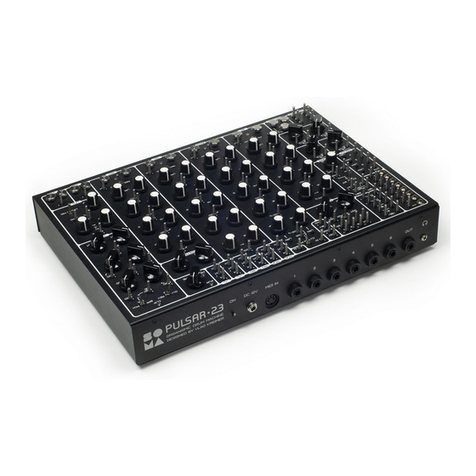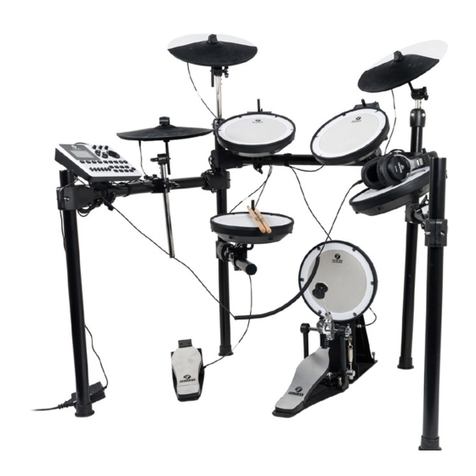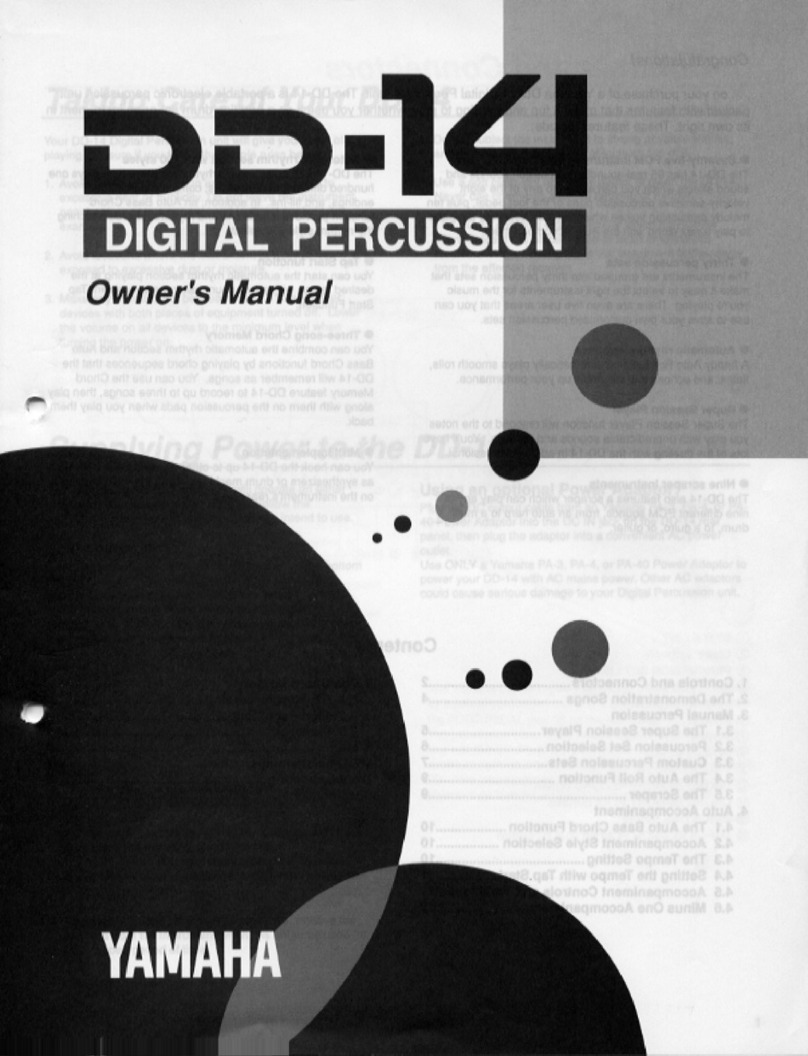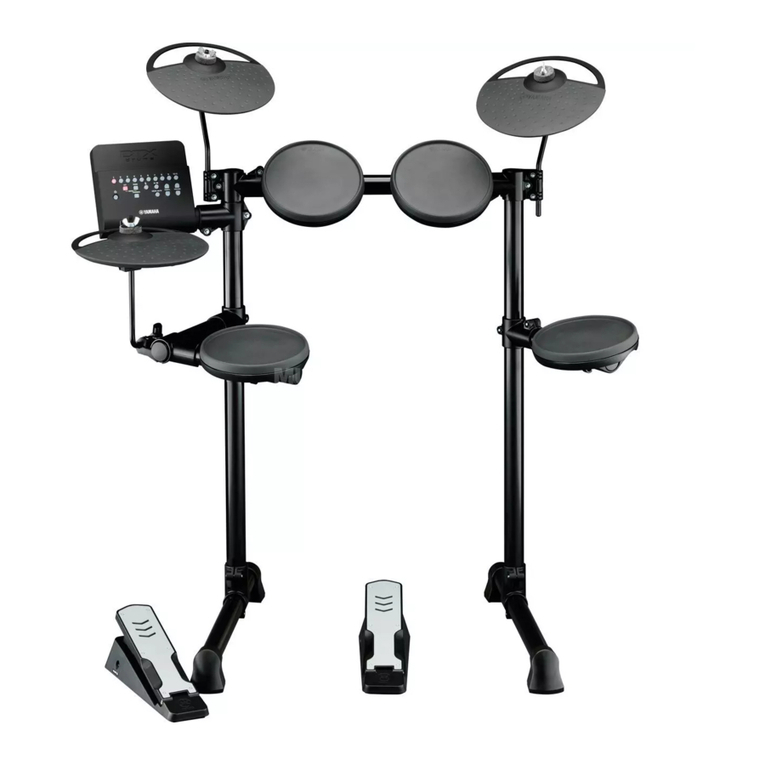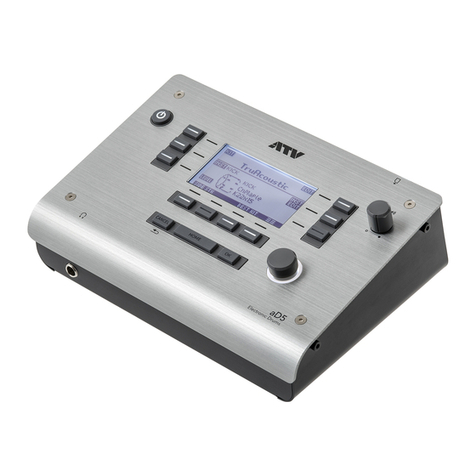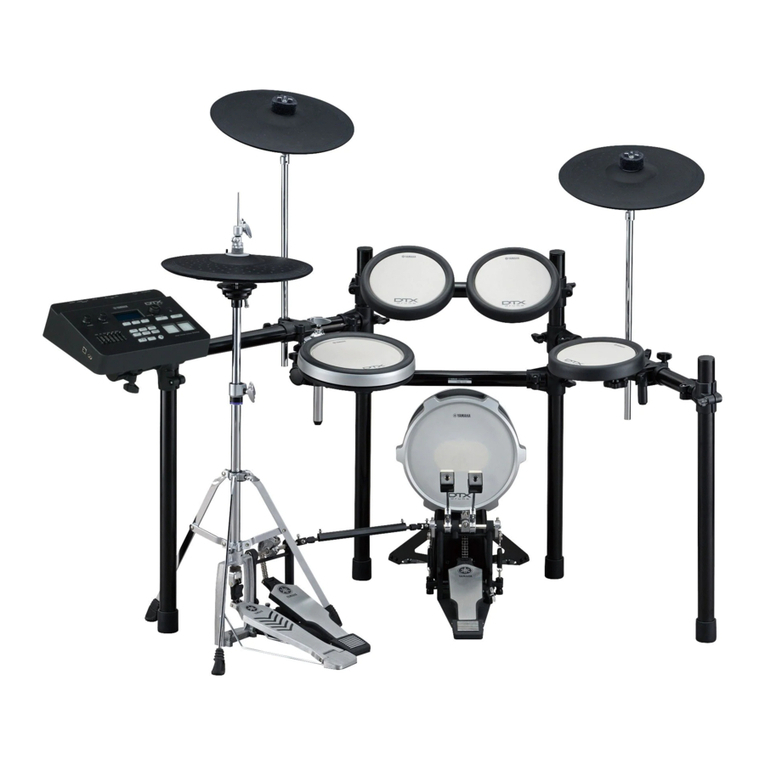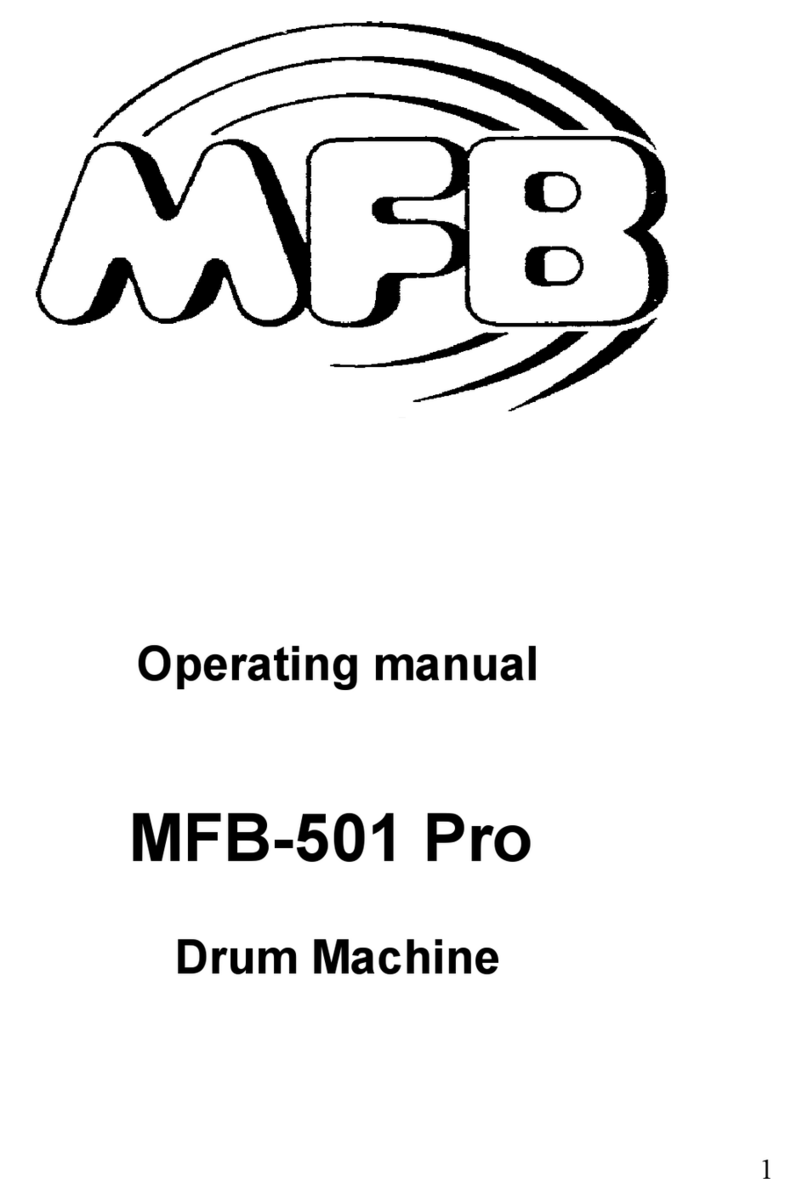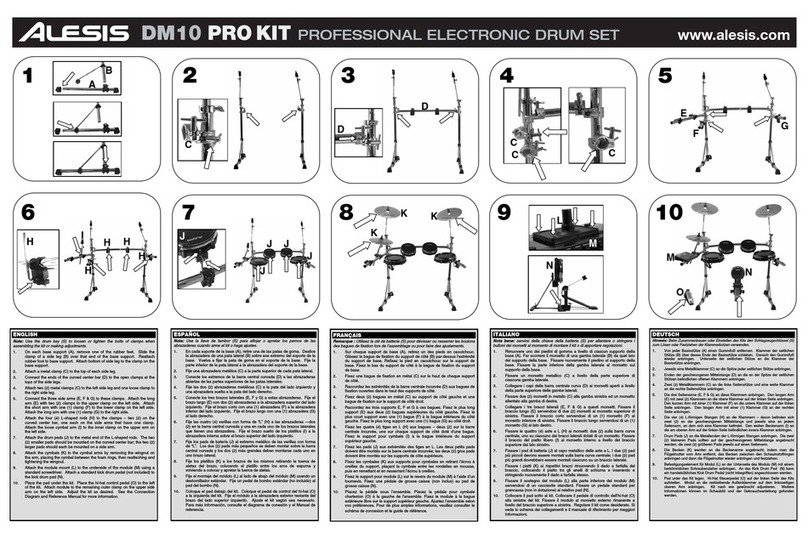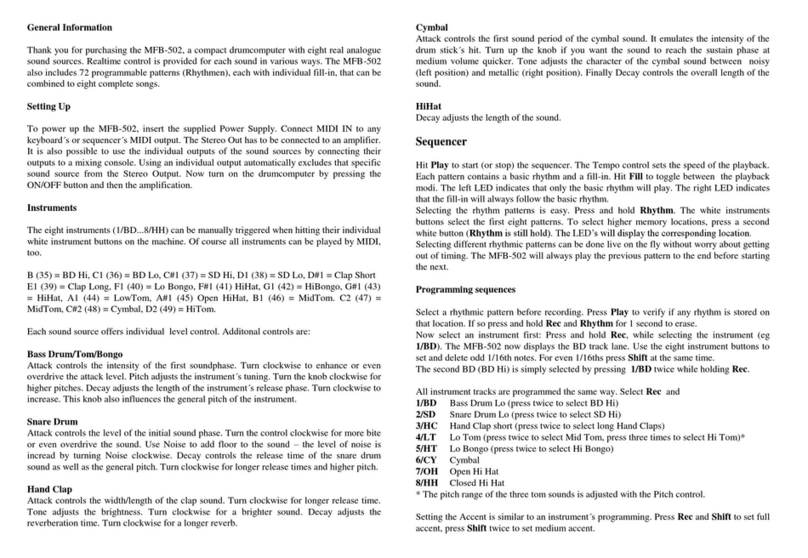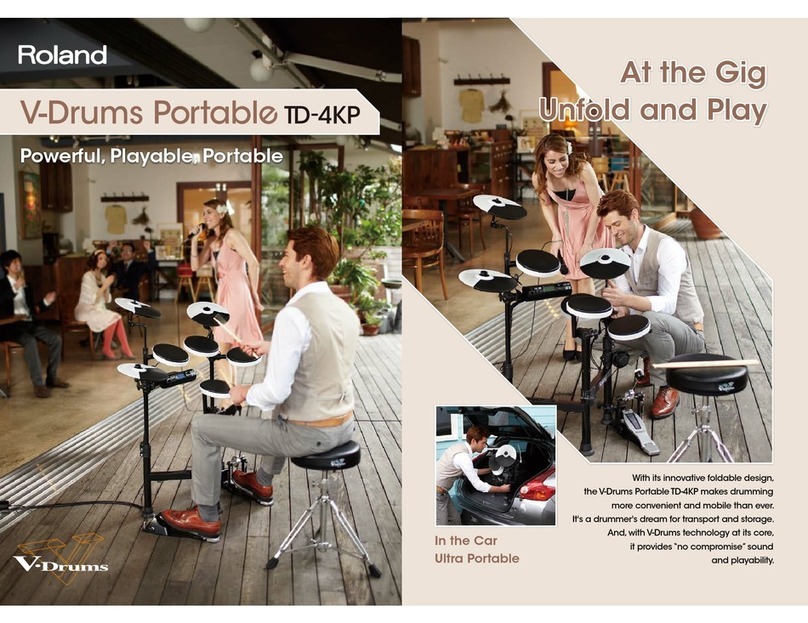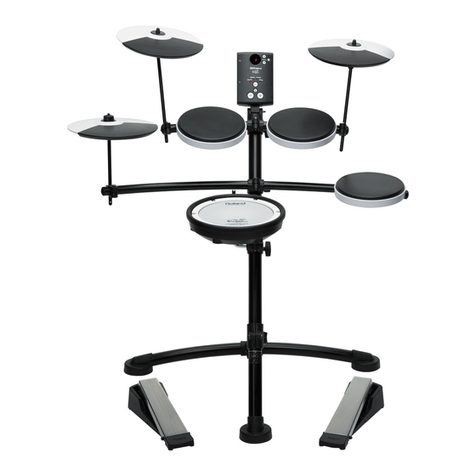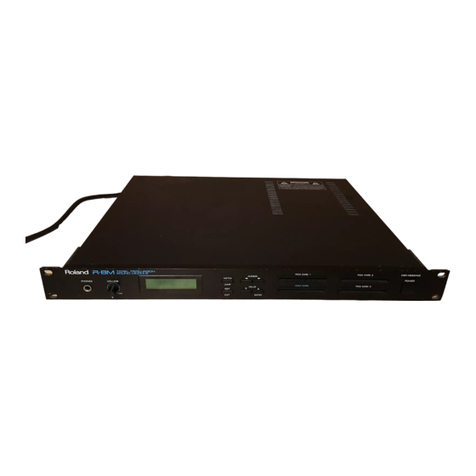SOMA Pulsar-23 User manual

I
The Pulsar-23 Notebook : Reference & Guide
PULSAR 23
A Guidebook
A Notebook
A Reference Book
Ver
1.0

II The Pulsar-23 Notebook : Reference & Guide

IV The Pulsar-23 Notebook : Reference & Guide

Pulsar-23 is described by SOMA as an
organismic drum machine and it truly lives up to
this description. Unlike a typical drum machine,
Pulsar-23 aims towards experimental sound
design and creative exploration. Organic patch
routings use natural or clock oriented
modulation rather than xed grid based
sequencing. There are four sound generation
voices which can of course operate inline with
the principles of more traditional drum synths.
However the real power and beauty of
Pulsar-23 is in the things that make it different
from a routine drum synth. While Pulsar-23
brings lots of new, creative and innovative
features it does not step away from synthesis
traditions. In fact the opposite. A fully analog
signal path for audio adds a unique character
along with classic warm sounds and a touch of
digital control to support the user ‘hands on’
experience. In terms of architecture, Pulsar-23
follows the principles of modular synthesis with
dened elements that can be used discretely or
together as per their default wired routing. Each
module can also be patched together with others
using alligator clip cables or human touch.
Pulsar-23 also includes incoming MIDI control
and the ability to interface to modular systems
and other gear. A dedicated master effect section
with reverb, delay plus a distortion option is also
featured. There is an almost ‘anything goes’
principle when working with this drum synth and
be sure to expect the unexpected. It is therefore
strongly advised to approach Pulsar-23 with an
open mind and embrace the innovation, unusual
features and it’s almost endless options that can
be applied for sound design, modulation and
patching. This producer guide is aimed to get the
best from Pulsar-23 for new and experienced
users. Think of it as an extension to the manual,
bringing a user perspective alongside the SOMA
expertise along with space for your own notes
too. The Pulsar-23 organismic drum machine
does not play by the rules and this is what makes
it special and unique.
Overview
5
The Pulsar-23 Notebook : Reference & Guide
1

6The Pulsar-23 Notebook : Reference & Guide
Overview
1
1.1 How to Use This Guidebook
This book sits alongside the existing SOMA quick start and ofcial manual
for Pulsar-23. It brings a different perspective to user experience and goes
a little deeper on some of the unique functionality.
The design means it acts as a reference, a guidebook and also a notebook
with ‘designed in’ space to capture your own notes and comments. Making
it personal in order to build a comprehensive producer guide for new and
existing users alike.
Diagrams used in this book are for illustrative purposes to help inform on
how Pulsar-23 works in a practical and functioning environment. They are
not intended to represent exact electronic schematic or circuit diagrams.
For example the lters have a very complex parallel circuit but are
illustrated here as functions in the series.
Book Conventions
The book uses a style to make it easy to understand the functions of
Pulsar-23 and follow the guidance simply.
LRN Any dedicated front panel labelled function will be described with
capital letters e.g. LRN.
(AMT) Rounded brackets / parenthesis represent parameters that are
adjustable using one of the 55 front panel control knobs.
[BANK] Square brackets / parenthesis represent one of the 15 capacitive
sensor buttons. These may be preceded by the module name.
{REC} Curly brackets / parenthesis represent the position of one of the front
panel switches e.g. Record / Play Switch {REC PLAY}.
‘MOD’ Patch points will be described by it’s purpose and context and will carry
quotation marks to indicate the specic patch point.
Elements that are labelled only by a symbol will be described in context
of the topic in the text e.g. Diode, Capacitor, Gate to Trigger.
Your Notes Can be
written here …..
NOTES

Overview1
7
The Pulsar-23 Notebook : Reference & Guide
On / Off Switch and 12V DC Power Input
Use the supplied PSU. Pulsar-23 requires centre
positive, 300mA min with good stability.
MIDI 5 Pin DIN Input
+
6 x 1/4inch, Male Mono TR Jacks for external inputs
and outputs. Connected through 1/4 Jack Patchbay.
Main Output 1/4inch / 6.35mm, Mono
and 3.25mm Stereo Headphones out.
1.2 Hardware Overview
Pulsar-23 is supplied, as well as the unit, with the 12V Power Supply Unit , 20 x 65mm alligator clip
patch cables, 10 x 30mm alligator clip patch cables, soft travel case and packaging.
380 mm
280 mm
80 mm
Including Controls

8The Pulsar-23 Notebook : Reference & Guide
Circuit Bending
Adds components and converts
sustained gates to triggers.
FX Section
Master delay and reverb effects. BD Bass Drum
Bass drum audio generator voice.
Eurorack to Pins Patch Bay
Converts 3.5mm to a pin connector. Main Output Volume Control
Level control, power / MIDI indicators. Recorder Control
Multi functional buttons.
Clock Section
Clock pulses and dividers. Distortion
Master distortion effect. BASS
Bass channel audio generator voice.
Looper Reset
Synchronise and restarts the looper.
Section also has Noise, +10V & GND
SHAOS
Chaotic sample & hold generator. SD Snare Drum
Snare drum audio generator voice.
Mix In
Additional external audio input. MIDI CV
Incoming MIDI learnt to pin points. HHT Drum
Hi Hat audio generator voice.
Voltage Controlled Ampliers
2 VCA’s controlled by CV. Low Frequency Oscillator
Single LFO modulation source. Dynamic Sensors
2 CV Controls. CV generated by touch.
Inverters
2 Inverters, one is CV controlled. Attenuators
4 Audio or CV controllers.
Switches
2, CV Controlled audio / CV switches. 1/4 Jack Connections
Patchbay to/from rear connectors.
Overview
1
1
12
11
14
13
15
2 3 4 5 6 7 8 9 10
16 17 18 19 20 21 22
2 10 18
1 9 17
3 11 19
4 12 20
5 13 21
6 14 22
7 15
8 16
1.3 Overview of Functions

9
The Pulsar-23 Notebook : Reference & Guide
Overview1
NOTES 1.4 What Makes Pulsar-23 Different?
Pulsar-23 is not a conventional drum synthesizer and while it does hold
onto some classic analog features, it aims to build further on these and also
take a different path to most drum machines. A summary of some of the key
differences from the norm will help to get to know Pulsar-23 and set the
expectations for the onward journey. The available features don’t
necessarily make an instrument better nor make it worse, they just make it
different and each will t based on individual preferences and needs.
Traditional / Typical Drum Synthesizers. Pulsar-23 Organismic Drum Synthesizer
Audio is usually sample based, analog
or digital. Multiple channels. Four analog audio channels for character
and warmth. Some digital control of
advanced features.
Linear audio channels with rigid
sequential functions. Non-linear structure with patchable
functions. Everything can interact with
everything.
Generally xed control functions and
signal path. Modular approach for patchable CV
and/or Audio to recongure and change
circuit defaults.
Sometimes CV or Audio patching with
3.5mm or 6.35mm plugs and cables. Alligator clip cables and also human
touch patching options. Raised patch
point pins for easy access. Patching
between CV and / or Audio possible.
Variable grid based time signature step
sequencing and recording. Clock based sequencing and per channel
loop recording options. Multiple clock
divider values and patch points.
Pads offer manual trigger control. Organic controls to trigger the sound
sources but also to provide a natural
modulation source.
Dened MIDI Input mapping and
control. Learn function to assign MIDI controls to
patchable inputs.
Circuit bending would require intrusive
adaption of the physical circuitry. Circuit bending options built in. Electronic
components can be patched in.
LFO shapes and envelope modulation
with control signals and parameters. Modulation sources includes the LFO
and across audio and / or CV elements
as well as human touch. Also the crazy
SHAOS sample and hold style generator.
On board effects. Reverb and Delay are provided in the in
the analog audio path from FX sends.
Also a master Distortion.
Typical drum synths output the audio
generated. Some may have audio input
options for example to use its effects.
6 two way audio input/output points,
converted to/from Pulsar-23 patch points.
External audio also can be patched in.

10 The Pulsar-23 Notebook : Reference & Guide
Overview
1
1.5 Glossary of Terms
While you may think this should be hidden at the back of this book, understanding the terminology
associated with these topics and especially the Pulsar-23 will help unlock it’s power and
performance. It makes sense to become familiar early with the essential terms to help embed into
your workow.
Attenuator: A function which can control a signal by
turning it down thereby attenuates the signal. Think
of a volume control as an attenuator. Pulsar-23 can
attenuate both CV and Audio signals.
Bank: The organisation of looper recordings,
structured in banks, accessible with the
REC.CONT Recording control. There are 4 banks,
each of which consists of 4 loops.
Capacitor: An electronic component that stores
energy when charged and releases energy to the
circuit when required. Adds character within the
circuit bending options of Pulsar-23 and changes a
signals shape.
Clock: The element that manages the timing of the
Pulsar-23 controls, and affects loop lengths. The
CLK - Clock signals can be patched to create and
control loops and sequences.
CV: Control voltage is commonly found in modular
systems and allows patching and interconnection
between functions using voltage ranges to control
parameter settings and create modulation.
Pulsar-23 has +10V patching options and uniquely
on board CV and Audio can also be patched to
interact creatively together.
Diode: An electronic component that passes
current only in one direction and operates with a
non-linear resistance. Adds character and cool
features within the circuit bending options.
Envelope: An ENV - Envelope is used to modulate
and shape parameters and audio over time.
Pulsar-23 has an ATT - Attack and REL - Release
envelope assigned to each of it’s four voices.
External. External controls and audio can be
connected from another separate device to
Pulsar-23. The MIX IN and EXT patch points allow
audio patching while MIDI and CV patching offers
control interfacing.
Feedback: This is a technique often found within
effects and electronic instruments where the
output from a sound (or part of) is fed back into the
input. Delays for example use FB - Feedback to
develop an echo effect.
Filter: A lter is a function that cuts (attenuates) or
boosts FREQ - frequencies at selected points in
the audio spectrum to help shape the sound. The
key elements represented in Pulsar-23 are FR -
Frequency cutoff point and Q - Resonance, which
boosts the level at the frequency cutoff point.
FX: A number of master effects are provided
including REV - Reverb or DLY - Delay as
congurable effects as well as a distortion effect.
Gate: Similar to a trigger but more typically a more
sustained ‘on’ pulse that initiates an event until the
gate is ‘off’. Pulsar can transform gates to triggers
within the circuit bend section.
Inverter: A function which takes an input and
inverts and changes it on its output. For example a
signal range of 0-10 on the input would become
10-0 at its output.
LED: Light Emitting Diode. An illuminated light that
provides a visual indication of a state.
LFO: Low frequency oscillator which is normally
used to modulate parameters for sound design
and movement but in Pulsar-23, can be used to
generate sound.
Loop Recording: The process of replaying audio or
a pattern continuously in a dened cycle e.g. start
to end then start to end. Sounds can be triggered
to REC - Record in loop mode. The on-board
functions, REC.CONT - Recording control and also
the LRST - Looper restart support loop control.
Loop recorder is sometimes called LR.

11
The Pulsar-23 Notebook : Reference & Guide
Overview1
MIDI: MIDI stands for Musical Instrument Digital
Interface and is a standard protocol used for
communicating between audio equipment. MIDI
Input is applied using 5 Pin MIDI DIN connection.
Pulsar-23 also has a LRN - Learn function to map
incoming MIDI CC to it’s controls and functions.
Modulation: Modulation is the ability to control and
manipulate one parameter from another. This
provides creative soundscapes. This is applied by
patching across functions and especially MOD -
Modulation points.
OMG!: A unique Pulsar-23 creative modulation
feature operating on the BD VCO that really needs
hands on experimentation to make it what you
want it to be.
Parameter: The individual value of a specic
function or control element. A parameter can be
adjusted for example setting an AMT - Amount to
affect a sound or to control a function or VOL -
Volume to adjust level.
Patch: A term used to refer to the connection
between two or more elements in a circuit or in a
conguration. Pulsar-23 uses xed patch pins and
removable alligator clip cables to patch between on
board as well as external modules.
Percussion: Percussion refers to instruments
played by striking with an object or by hand such
as drums or chimes. Pulsar-23 is a drum machine
and can be played by hand or by controls as a
PRC - percussion instrument but also can offer
bass and drone sounds too.
Power: Pulsar-23 is supplied with PWR - Power
using the dedicated power supply. On board points
for GND - Ground and +10V - DC 10V are used for
patching.
Pulsar-23: Pulsar-23 is an organismic drum
machine. This brings analog drum synthesis
together with experimental and organic modulation
and control.
SHAOS: This is a cyclic pattern generator building
on classic S/H - Sample and Hold and RNG -
Random Note Generator shift registers.
Sound Generators: Pulsar-23 has 4 dedicated
sound generators; BD - Bass Drum, BASS, SD -
Drum and HHT - Hi Hat. Sound can also be
generated by other Pulsar-23 functions.
Switch: A function that fully opens / turns on or
closes / turns off the signal ow between
elements.
Synchronisation: This is the alignment of functions,
generally through timing of various elements. For
example to manage multiple clock signals or to
synch the looper recorder or LFO.
Trigger: Similar to a gate but a shorter decaying
pulse that initiates an event. For example a
manual TRIG - Trigger can initiate a drum synth to
play or record a beat. Trigger can be manually
initiated for recording by tapping ADD - Add. To
remove the recorded beat press DEL - Delete.
Velocity: Velocity is a feature which allows a
response based on how hard a trigger is activated.
This would be typically how hard a keyboard key is
pressed or drum pad is hit. Pulsar-23 records a full
velocity range from an external MIDI controller.
Internal controls can only be triggered at three
velocity levels; L - Low, M Medium / Middle and H -
High (L+M).
Voice: In synthesis language, a voice is an audio
channel with dedicated features that control and
manage an independent audio pathway. For
example a mono synth has one voice allowing only
one note at a time. Poly synths will allow chords by
using multiple voices. Pulsar-23 has 4 voices, one
for each sound generator.
WTF?: A unique Pulsar-23 creative modulation
feature operating on the BD Pitch envelope that
really needs hands on experimentation to make it
what you want it to be.

12 The Pulsar-23 Notebook : Reference & Guide
1.6 Structure of Pulsar-23
While Pulsar-23 is very different to the traditional drum machine it follows
some core principles of synthesis especially with respect to the sound
sources. In addition the workow and operation heavily relates to the
principles of modular synthesis; make sound - shape sound - move sound.
Remember Pulsar-23 does not follow a linear signal ow and these
elements can be connected and combined in many ways. Experimentation
and just trying things is the way to go.
MAKE SOUND
MOVE SOUND
FX
SHAPE SOUND
NOTES
Overview
1
BD
CLOCK
BD
Tune
Drive
Tune
Clap
Tune
Creation and generation of sound sources
Sound is adjusted and shaped
Modulation, manipulation, routing and control to
create movement, interest and connect elements
Warp
Tune
Warp
Envelope Envelope
BP Filter
Envelope
LP Filter
Envelope
HP Filter
BASS
SHAOS
CIRCUIT BEND
DISTORTIONDELAY REVERB
+
LOOP REC
BASS
VCA ATTENINV
SD
CV
SD
HHT
LFO
HHT

13
The Pulsar-23 Notebook : Reference & Guide
While Pulsar-23 has a series of modules with an almost endless set of
patching congurations. This encourages wild and crazy experimentation.
However, there is still a core underlying structure when unpatched. This
allows building around the default ‘in the box’ wired routings.
Unpatched - Hard Wired Routing
Clock Generator
Looper
FX
OUTPUT
BD BASS
Sound Modules
SD HHT
Overview1
NOTES

14 The Pulsar-23 Notebook : Reference & Guide
NOTES

Pulsar-23 has four primary sound generators
for each of the four synth voices. These are
designed to suit the characteristics of bass
drum, melodic bass, snare drum and high hat.
The conguration and settings can however go
beyond just the percussive replication of these
sounds for example to create drone engines.
While these are the main sound sources it is
important to recognise that other functions can
be manipulated and patched to generate sound
too. For example the LFO which traditionally is
used below sonic levels can be used as an
audio oscillator. There is also a noise feature
located within the looper reset section.
Remember that the Pulsar-23 has no hard
rules between CV control and Audio patching.
Freedom to create and experiment in the
discovery of sound source elements, even
where they may appear less obvious is
encouraged. Remember a core principle of
Pulsar-23 is that control functions can generate
sound and audio functions can be used as
controls, all when patched with the right setup.
Each of the primary generator modules has its
own set of parameters and controls to make the
sound and to shape it to personal taste. The
synthesis features differ signicantly between
modules, where each is unique. There are some
common features, that operate in the same way.
These include volume, envelope attack and
release and loop recorder. The modules can be
triggered manually using the module ADD
buttons or by using clock patching. They can also
be recorded and controlled using the looper
recorder. Multiple patch points allow for an
expansive range of modulation and routing
options. This section concentrates on the four
primary sound sources, their features and
controls as well as some basic patching topics.
Sound Generators
15
The Pulsar-23 Notebook : Reference & Guide
2

16 The Pulsar-23 Notebook : Reference & Guide
2.1 Sound Module Overview
Pulsar-23 has 4 specic audio generation modules, each with a unique
sound engine and a feature set for sound design and shaping. Others can
of course generate audio but these 4 audio modules are covered here as
the primary audio sources.
BD Designed to emulate the character and timbre of bass drums and is
based on a triangular waveform at its core. Drones and soundscapes
can also be generated. PITCH and DRIVE are unique parameters.
BASS Aimed to add a melodic bass instrument with a digitally controlled
oscillator at its core. Percussion mode also helps generate percussive
sounds too. A low pass lter aids sound design as well as the
dedicated SHAPE and WARP parameters.
SD Designed with a noise generator at its core to emulate the snap and
timbre of snare drums and also introduce an additional clap sound.
Drones and soundscapes can also be generated. A band pass lter is
included for SD. CLAP and MIX also offer more percussive sound
design options.
HHT Designed to emulate the shrill and tone of hi hats, shakers and
cymbals. Drones and soundscapes can also be generated. A high pass
lter is included as well as WARP parameter to aid sound design.
NOTES
Sound Generators
2
Common VCA Features
Channel Independent
Four Independent Sound Generators
One Sound Generator per Voice
Unique Synth Features
Channel Independent

17
The Pulsar-23 Notebook : Reference & Guide
2.2 Triggering Sounds
Sounds can be triggered by multiple options individually or at the same
time. Triggering does not initiate the direct sound creation but actually
triggers the modules envelope. Trigger sources include:-
1. Manually triggered by hand by tapping / holding the ADD sensor buttons
for each module.
2. Patching a trigger signal from the clock or input from a modulation
trigger source. Patching with cables or by human physical patching.
Note that the TRIG pin carries the envelope trigger input and also the
loop recorder channel output.
3. Each module can be triggered by it’s loop recorder which can record
and then playback the triggering of sounds.
4. Incoming MIDI signals from external gear can also trigger the sound
generators. MIDI LRN button will map the input to the sound module.
Sound Generators 2
NOTES
Core Sound
Source
[ADD]
Sensor Button {PLAY}
Loop Recorder
Patched
‘TRIG’ MIDI
LRN
Output
Parameters
The length of the sound is determined by duration that the trigger is present
All of the trigger inputs can be applied individually or simultaneously.
The strongest signal (highest voltage) will determine which trigger takes precedence
Envelope
Sound Module

18 The Pulsar-23 Notebook : Reference & Guide
Envelope Generators
Each sound module has its own envelope generator which is integrally
congured to control volume. An envelope is triggered to control the
activation and shape of the sound as it develops over time. This is also
based on the duration of the trigger state. An AR - Attack / Release
envelope type is used in Pulsar-23, a model often used for drum sounds.
NOTES
Sound Generators
2
A short trigger will initiate the ATT - Attack phase ramping up the sound level
and when the trigger is off the REL - Release time will control the audio ramp
down. This is typical for percussive hits and the envelope adjusted to suit.
A long trigger will initiate the ATT - Attack phase ramping up the sound level
and then will be sustained for the duration. When the trigger is off the REL -
Release will control the audio ramp down time. This is typical for drones and
pads and the envelope can also be adjusted to suit.
TRIG
ON
TRIG
ON
TRIG
OFF
TRIG
OFF
Attack Time
(ATT)
Attack Time
(ATT) Sustain Level
with duration
based on trigger
Release Time
(REL)
Short Trigger
Long Trigger
Release Time
(REL)

19
The Pulsar-23 Notebook : Reference & Guide
Sound Generators 2
NOTES
The envelopes are adjusted manually using the (ATT) - Attack and the
(REL) - Release rotary knobs. A set of envelope controls and patch points
exists within each sound generator.
The envelope generator also has an output which can be used separately
from the sound module for modulation control and complex patching to any
other function. This is patched from the ‘ENV’ Pin.
The typical behaviour and dynamics of percussive sounds would aim for
short attacks for punch / impact at the start followed by a tail that is then
controlled by release time. While a sound may have a natural envelope, the
AR functions can offer more precise sound design options and also to help
move beyond just percussive sound design.
▌MANUALLY SETTING UP THE ENVELOPE
1. Ensure the sound module looper switch is in {Play} mode.
2. Set the (ATT) and (REL) Knobs down - fully counter clockwise.
3. Tap [ADD] to trigger the sound to adjust. It is advised to always tune the
envelope settings to your desired objectives by ear.
4. Start by increasing the (ATT) in small amounts followed by increasing
the (REL) knob. The effect will be heard when triggering.
5. This is an incremental and iterative process so tweak and adjust until a
desired state is found. This may be revised during further sound design
and development adjustments of other parameters.
Envelope Output
for patching
Release Time
Control
Natural percussive audio shaped by the envelope.
Attack Time
Control
External Trigger
input / output

20 The Pulsar-23 Notebook : Reference & Guide
Manual Trigger Buttons
Each sound module has two sensor buttons which operate by the
capacitive nature of a human touch. These are multifunctional and can
operate various functions. They can be used to manually trigger the sound
generator envelopes and hence initiate the sound.
Velocity is the behaviour recognised by an instrument of how hard a note is
triggered or a drum pad is pressed, technically dened as speed of an
object with a direction. For example light or hard touch on a piano key will
often correspond to its loudness. Pulsar-23 can recognise velocity, but is
only controllable from an external MIDI controller. Internally, Pulsar-23 can
trigger the sound generators at 3 manually selectable velocity levels.
Looper set to {PLAY} - Switch Right or {MUTE} - Switch Centred, also
when clock is stopped, allows live, real time triggering.
Tap or Hold [ADD] to trigger
the sound envelope. Hold [DEL] to mute any recorded
events when in {PLAY} Mode
Full velocity when
played alone
[L] + [ADD] Low Velocity
[M] + [ADD] Mid Velocity
[L] + [M] + [ADD] Max Velocity
Red LED will illuminate when a
trigger for the sound is initiated
NOTES
Sound Generators
2
Other manuals for Pulsar-23
1
Table of contents
Other SOMA Drum manuals

